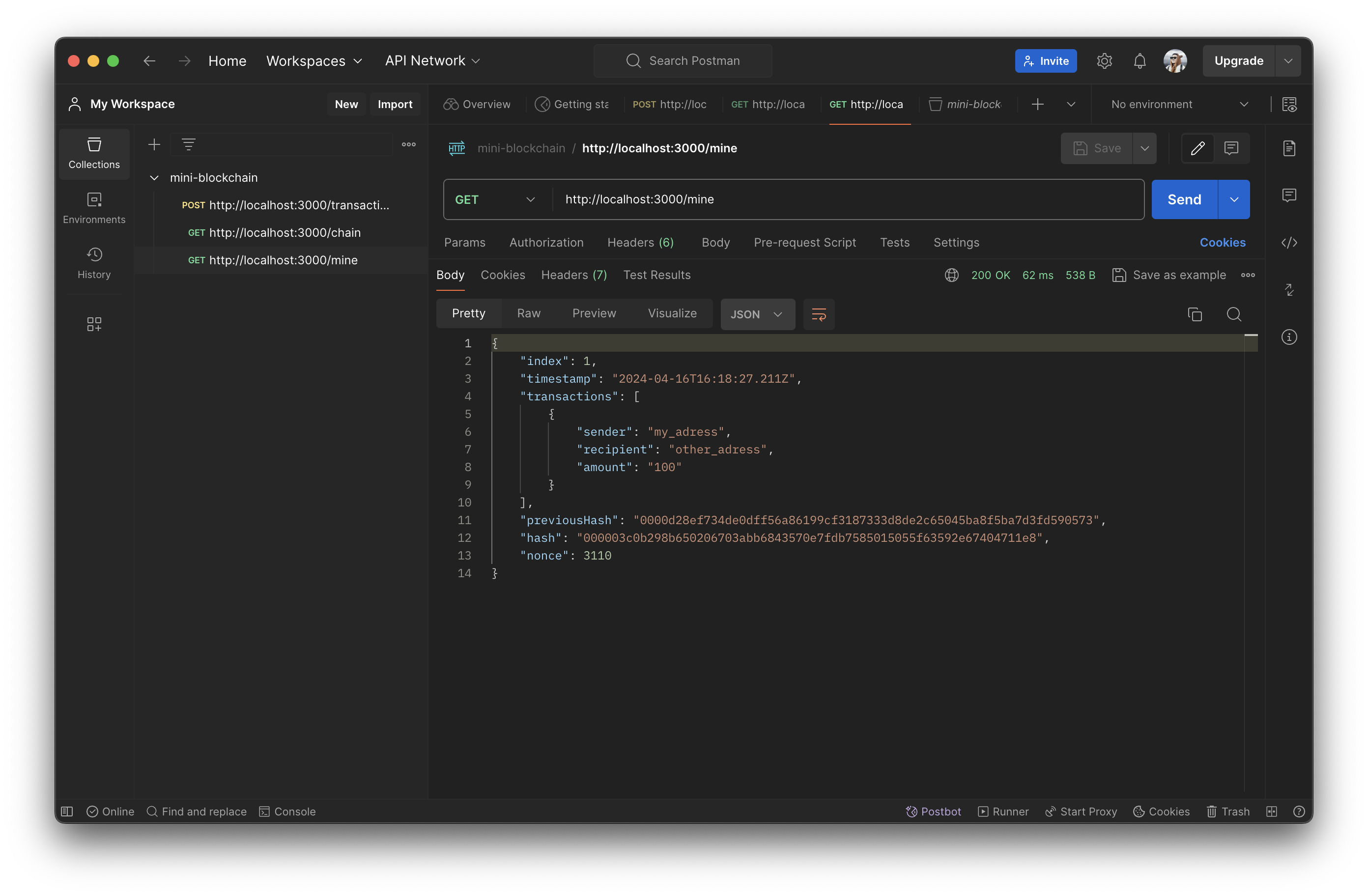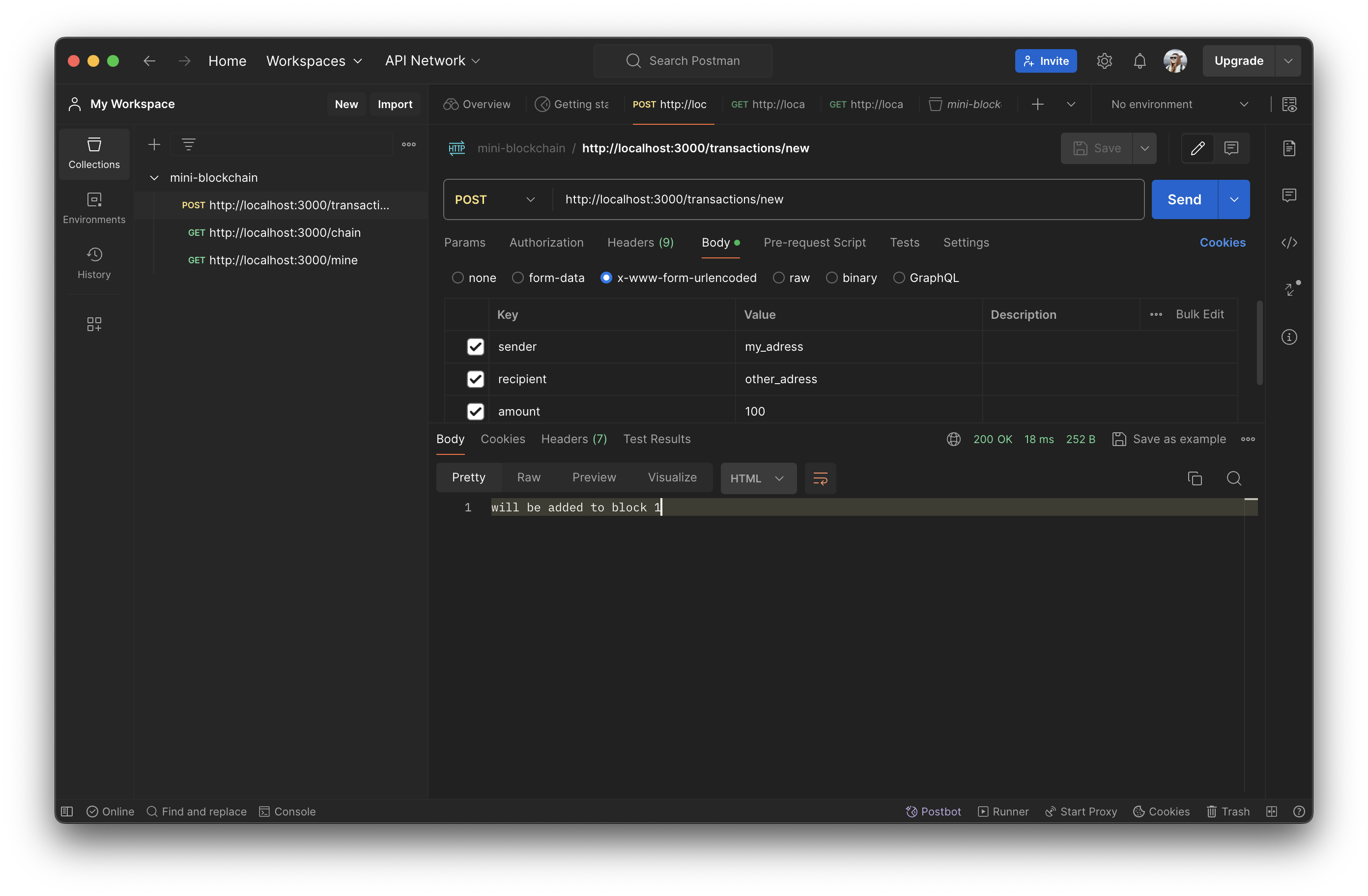使用JavaScript实现一个简单的区块链
- Carry
- 发布于 2024-04-19 00:30
- 阅读 3850
本文使用JavaScript实现一个简单的区块链,主要在node.js环境中运行。使用crypto-js来为区块链中的块创建哈希加密,使用express.js来创建用于与区块链交互的API。
本文使用JavaScript实现一个简单的区块链,主要在node.js环境中运行。使用crypto-js来为区块链中的块创建哈希加密,使用express.js来创建用于与区块链交互的API。 本文源代码可查看:GitHub - CarryWang/mini-blockchain: use node.js implement a mini blockchain
以下是实现区块链的步骤:
- 创建一个新的Node.js项目并安装必要的库:crypto-js、express。
- 定义区块链中的区块结构。每个块应该包含唯一的索引、时间戳和想要存储在块中的数据。
- 创建一个区块链类,包含一些操作区块的方法,例如向链中添加新块。
- 使用 express.js 创建api,可以使用postman查询区块链,添加交易,以及执行挖矿操作。
- 使用 postman 测试区块链。
1. 创建一个新的Node.js项目并安装必要的库:crypto-js、express。
首先初始化一个node项目:
npm init在package.json文件中,添加type字段:
"type": "module"安装crypto-js和express:
npm install crypto-js npm install express npm install body-parser在index.js中写入:
import express from "express"; import bodyParser from "body-parser";
const app = express(); const port = 3000;
app.listen(port, () => {
console.log(Example app listening on port ${port});
});
在terminal中输入:
```javascript
node index.js你将看到:
Server running on port 3000.到这里,基本的node.js设置搞定。
2. 定义区块链中的区块结构。每个块应该包含唯一的索引、时间戳和想要存储在块中的数据。
新建blockchain.js文件,定义我们的区块结构:
import crypto from "crypto-js";
class Block {
constructor(index, timestamp, transactions = [], previousHash = "") {
this.index = index;
this.timestamp = timestamp;
this.transactions = transactions;
this.previousHash = previousHash;
this.hash = "";
this.nonce = 0;
}
calcHash() {
return crypto
.SHA256(
this.index +
this.timestamp +
JSON.stringify(this.transactions).toString() +
this.previousHash +
this.nonce,
)
.toString();
}
mineBlock(difficulty) {
while (!this.hash.startsWith("0".repeat(difficulty))) {
this.nonce++;
this.hash = crypto
.SHA256(
this.index +
this.timestamp +
JSON.stringify(this.transactions).toString() +
this.previousHash +
this.nonce,
)
.toString();
}
}
}
Block类包含6个属性,2个方法。
index:数字,区块的索引。timestamp:数字,时间戳。transactions:数组,储存每一笔交易信息。previousHash:哈希值,记录上一个区块的哈希值。hash:哈希值,记录当前区块的哈希值。nonce:数字,用于找到满足特定条件的哈希值的随机数,pow相关。calcHash:函数,计算哈希值,将index,timestamp,transactions,previousHash,nonce拼接在一起输出哈希值。-
mineBlock:函数,用于工作量证明的方法,接受一个代表复杂度的数字。本文对于工作量证明的计算条件为:寻找前4位为0的哈希值。3. 创建一个区块链类,包含一些操作区块的方法,例如向链中添加新块。
同样在
blockchain.js文件中,定义一个区块链类:export class Blockchain { constructor() { this.difficulty = 4; this.pendingTrasactions = []; this.chain = [this.createGenesisBlock()]; } createGenesisBlock() { const genesisPreviousHash = "0".repeat(64); const genesisBlock = new Block(0, Date.now(), [], genesisPreviousHash); genesisBlock.mineBlock(this.difficulty); genesisBlock.transactions.push({ sender: "", recipient: genesisBlock.hash, amount: 50, }); return genesisBlock; } createBlock() { const minerReward = { sender: "", recipient: "miner_adress", amount: 50, }; this.pendingTrasactions.push(minerReward); const block = new Block( this.getLatestBlock().index + 1, Date.now(), this.pendingTrasactions, this.getLatestBlock().hash, ); block.mineBlock(this.difficulty); this.chain.push(block); this.pendingTrasactions = []; } getLatestBlock() { return this.chain[this.chain.length - 1]; } createTransaction(transaction) { this.pendingTrasactions.push(transaction); return this.chain[this.chain.length - 1].index + 1; } }
`Blockchain`类包含3个属性,4个方法。
- `difficulty`:数字,代表复杂度的数字。
- `pendingTrasactions`:数组,资源池,用于存储每一笔交易。当新的区块产生时,会将资源池中的交易信息存入新区块中。
- `chain`:数组,储存每一个区块。
- `createGenesisBlock`:函数,创建第一个区块(创世块)。
- `createBlock`:函数,创建新区块。
- `getLatestBlock`:函数,返回最后一个区块。
- `createTransaction`:函数,创建一笔交易,返回将被写入区块的索引值。
## 4. 使用 express.js 创建api,可以使用postman查询区块链,添加交易,以及执行挖矿操作。
接下来需要实现三个api,分别是:
```javascript
GET /chain //查看区块链
GET /mine //执行挖矿,成功后增加一个区块
POST /transactions/new //添加一笔交易回到index.js中,导入blockchain.js,并添加route:
import express from "express";
import bodyParser from "body-parser";
import { Blockchain } from "./blockchain.js";
const app = express();
const port = 3000;
app.listen(port, () => {
console.log(`Example app listening on port ${port}`);
});
app.use(express.json());
app.use(bodyParser.urlencoded({ extended: false }));
app.use(bodyParser.json());
const blockchain = new Blockchain();
app.get("/mine", (req, res) => {
blockchain.createBlock();
res.status(200).send(blockchain.chain[blockchain.chain.length - 1]);
});
app.post("/transactions/new", (req, res) => {
// const transaction = {
// sender: "sender_adress",
// recipient: "recipient_adress",
// amount: 50,
// };
const transaction = req.body;
const blockNumber = blockchain.createTransaction(transaction);
res.status(200).send(`will be added to block ${blockNumber}`);
});
app.get("/chain", (req, res) => {
res.status(200).send(blockchain.chain);
});
5. 使用 postman 测试区块链。
测试 GET http://localhost:3000/chain:
 测试 GET http://localhost:3000/mine:
测试 GET http://localhost:3000/mine:
 测试 POST http://localhost:3000/transactions/new:
测试 POST http://localhost:3000/transactions/new:

- 比特币的应用场景和安全模式的多样性 86 浏览
- DePIN的崛起:区块链如何驱动2026年的绿色互联网 106 浏览
- 稳定币 vs 央行数字货币:谁将在2026年的数字货币竞赛中胜出? 116 浏览
- CrossFi Visa 卡的加密支付安全吗? 302 浏览
- $CARDS 看涨案例 302 浏览
- 区块链不是未来:这次崩盘证明了我一直以来所说的一切 339 浏览
- BlockThreat - 2025年第50周 395 浏览
- 16万亿美元的革命:代币化如何改写全球贸易 304 浏览
- 2026年的现实世界资产:代币化全球债务和信贷市场 77 浏览
- Layer1和Layer2:大肆宣传,毫无结果 288 浏览
- 21. 节点 & 验证者:因为显然更多计算机等于更好的真理 952 浏览
- 区块链如何帮助我们更快地找到治疗方法 44 浏览

